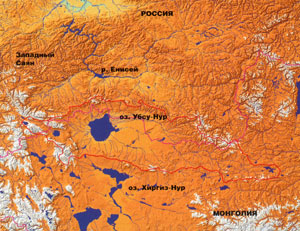Pearls of nature
Ubsunursk Hollow
 Ubsunursk Hollow, State Biospheric Natural Reserve. The World's Heritage Centre is considering the question of including of this reserve into The World's Heritage List.
Ubsunursk Hollow, State Biospheric Natural Reserve. The World's Heritage Centre is considering the question of including of this reserve into The World's Heritage List.
The reserve was organized in 1992 in the territory of the Republic of Tyva. Its total area is 39640 hectares, fenced-off area territory - 141440 hectares.
All the territory of the reserve is divided into 5 clusters, representing deferent types of ecosystems of Ubsunursk Hollow. In the territory of Russia they are: "Tsugeer Els" (its reserved area - 4900 hectares, fenced-off area - 5000 hectares), "Ular" (correspondingly: 18000 and 20480 hectares), "Yamaalyg" (800 and 4000 hectares), "Aryskannyg" (15000 and 11800 hectares), "Mongun-Taiga" (940 and 100160 hectares).
Uvsnur Reserve also occupies Ubsunursk Hollow but it lies in the territory of Mongolia.
Though, this area has not got a status of International Natural Protected Territory yet. Cooperation between the reserves is being just developed. Since 1984 biospheric researches have been carried out under the program of Russian(Soviet)-Mongolian experiment "Ubsu-Nur" in the territory of Ubsunursk Hollow. The program includes biological, historical and other researches, landscape-ecological map-making based on space photoinformation and mathematical modelling of natural processes and ecosystems dynamics.
Widening of a network of zones and increase of their area on both sides beyond the border line between Russia and Mongolia as well as common boundary between specially protected natural territories of both countries are necessary for creation of optimal organized transboundary territory.Ubsunursk Hollow located in the territories of Mongolia and Russia is one of the most original and unusual places of the Central Asia. This region preserved a unique complex of adjoining, closely interacting, extremely contrast ecosystems - from taiga to desert. Glaciers, snowfields, mountain tundra of Alpine zone and subalpine meadows turn into vast mountain-taiga zone replaced by forest-steppe, steppe, semidesert and even free sandy ridges, thus, creating exceptionally beautiful and variable natural phenomenon. It is hardly possible to see such a variety of landscapes in such close neighbourhood somewhere else on our continent.
The territory of the hollow lies in the sphere of interaction of European-Siberian and Central-Asian floristic and faunistic complexes. That defines its extraordinary for temperate latitudes high species diversity. Such different species as: snow leopard; Siberian deer, lynx and glutton; Mongolian lark, demoiselle, long-tailed ground squirrel; bustard and chick-weed are met in this territory. There are 359 species of birds here. This protective hollow serves as a natural shelter for many relic species that disappeared from other regions.
These territories, comparatively thinly populated and without industrial objects, represent a perspective natural laboratory for studying of biosheric processes. The kinds of economic activities developed here (for example distant-pasture cattle breeding) organically blend in with landscapes and under certain restrictions do not interfere in natural processes.
The importance of this territory is not only in the unique nature of Ubsunursk Hollow. The objects of cultural heritage located here - archeologic monuments, many of which are not investigated till now, also represent utmost significance. Nowhere else in the Central Asia burial mounds are met in such concentration as here (up to 20 000 according to rough estimate); the majority of them are older than the Egyptian Pyramids. Thousand of rock carvings and stone sculptures, remains of medieval settlements and buddhistic chapels form the unique natural-and-cultural landscape.
Secular traditions of harmonious coexistence of men and nature were carefully preserved here till nowadays; the ancient culture of steppe nomads is also alive, as well as famous Tuva guttural singing art.
Address: Erzin Settlement, Erzinsky Region, Tyva Rep., Russia, 668380
|